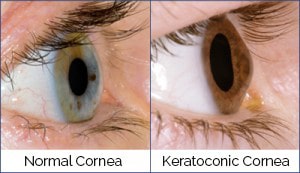 What is Keratoconus?
What is Keratoconus?
In its earliest stages, Keratoconus, often abbreviated to “KC”, is a non-inflammatory eye condition in which the normally round dome-shaped cornea progressively thins causing a cone-like bulge to develop. This results in significant visual impairment. The cornea is the clear window of the eye and is responsible for refracting most of the light coming into the eye. Therefore, abnormalities of the cornea severely affect the way we see the world making simple tasks like driving, watching TV, or reading a book difficult. Keratoconus causes slight blurring and distortion of the vision and increased sensitivity to glare and light. These symptoms usually first appear in the late teens and early twenties. Keratoconus may progress for 10-20 years and then slow or stabilize. Each eye may be affected differently.
Keratoconus Treatment
Eyeglasses or soft contact lenses may be used to correct the mild nearsightedness and astigmatism caused in the early stages of Keratoconus. As the disorder progresses and the cornea continues to thin and change shape, rigid gas permeable contact lenses are generally prescribed to correct vision more adequately. The keratoconus contact lenses must be carefully fitted and frequent checkups and lens changes may be needed to achieve and maintain good vision.
In severe cases, a corneal transplant may be needed due to scarring, extreme thinning or contact lens intolerance. Keratoconus surgery is a surgical procedure that replaces the Keratoconus cornea with healthy donor tissue.
The actual incidence of Keratoconus is not known. It is not a common eye disease, but it is by no means rare. It has been estimated to occur in 1 out of every 2,000 people in the general population. Keratoconus eye is generally first diagnosed in young people at puberty or in their late teens. It is found in all parts of the United States and the rest of the world. It has no known significant geographic, cultural, or social pattern.
What causes Keratoconus?
Keratoconus is a common disease that occurs in approximately 1 in 2,000 Americans. In this condition, the cornea becomes weak, progressively thinner, and irregular in shape which can cause high levels of astigmatism. Instead of a normal, relatively round shape resulting in clear vision, the cornea in a keratoconus eye can become cone shaped. This can interfere with the ability to see clearly, which is referred to as ‘keratoconus vision’. Often keratoconus patients first require glasses, then contact lenses, and, if the keratoconus symptoms progress to a severe level, a cornea transplant may be required for keratoconus treatment.

What is Astigmatism?
Astigmatism means that the front surface of the eye (the cornea or clear window in front of the eye) is less round and more irregular in shape so the image won’t focus clearly on the retina in the back of the eye. This can result in poor vision and glare.
Common Questions
Will insurance cover the procedure?
Insurance companies may cover all aspects of the keratoconus surgery. Since this is a new indication, some insurers may not yet recognize this procedure for keratoconus treatment. Addition Technology is working to educate insurers on the importance of the Intacs procedure for keratoconus treatment. You and your doctor may in some cases also need to help educate your insurance company. For more information and assistance, please visit our website at http://www.intacsforkeratoconus.com.
Where can I get more information?
If you are seeking a keratoconus specialist, please call our keratoconus eye center in Cleveland. Although your eye care professional is the best source of information, you may want to conduct your own research on keratoconus. A good place to begin is the National Institutes of Health at www.nei.nih.gov/health/cornealdisease.








